The early archives collection chronicles the organization and activities of the Society of the Cincinnati from the time of its founding to the early twentieth century. The minutes, correspondence, rosters, reports, artwork and other official papers offer scholars a rich record of the history of America’s oldest national veterans’ organization, whose interests and concerns overlap with many of the major issues of their times. In its first decades the Society faced public scrutiny and criticism, especially over the hereditary aspects of membership, but the organization emerged as a leader in national and local commemorations of the Revolution and its heroes. Correspondence about the establishment of the French branch of the Society provides a window into relations between the two nations in the years between the American and French revolutions. The Society’s benevolent work of supporting Revolutionary War veterans and widows carried on up to the time of the Civil War. Though greatly reduced in numbers during this period, the members of the constituent branches held fast to their founders’ vision to remain “One Society of Friends,” despite sectional divisions. And, inspired in part by the centennial celebrations in 1876, the Society underwent a major revival in the late nineteenth century, recommitting itself to its original mission to perpetuate the memory of the achievement of American independence.
From its earliest meetings, the Society took great care in organizing its official records, commissioning a special mahogany box in 1787 to house and protect them. For more than a century, the growing archives collection was kept in the personal custody of the Society’s secretary general, moving from house to house until 1911, when the Society arranged to have the collection housed with the Lincoln Safe Deposit and Storage Company in New York City. In 1930, the archives were placed on deposit at the Library of Congress, where they were made available to researchers and microfilmed. After the establishment of the library in the Society’s headquarters at Anderson House, the archives were returned to the Society’s care in 1973.
Read about the conservation of the original Society of the Cincinnati Institution, the organization’s founding document created in 1783.
Learn More About the Society of the Cincinnati
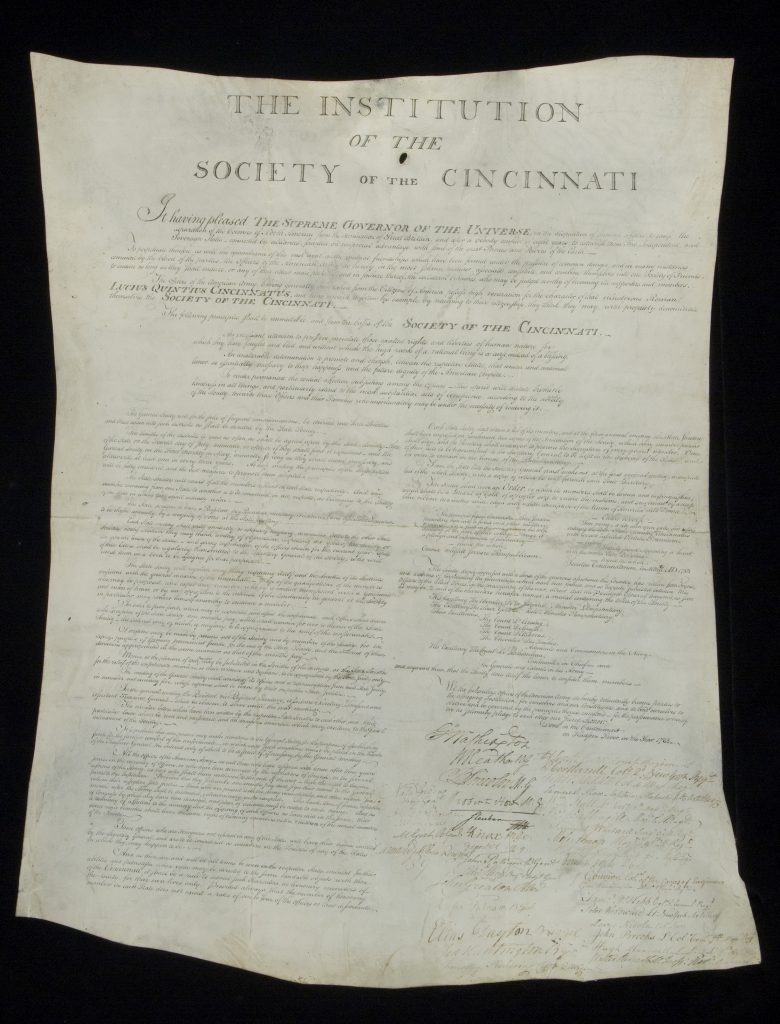
The Institution of the Society of the Cincinnati
May 1783The Society of the Cincinnati Archives
Adopted at the founding meeting on May 13, 1783, the Institution remains the principle guiding document of the organization to the present day. The first official copy was inscribed on a large, irregularly shaped sheet of parchment and signed by George Washington and thirty-five other officers. The Institution lays out the tenets and organizational structure of the Society, the rules of eligibility to membership, the establishment of constituent branches and details of the Society’s insignia. To join the Society, the original members were required to sign their names to the Institution, thus pledging their allegiance to the immutable principles upon which the Society was founded.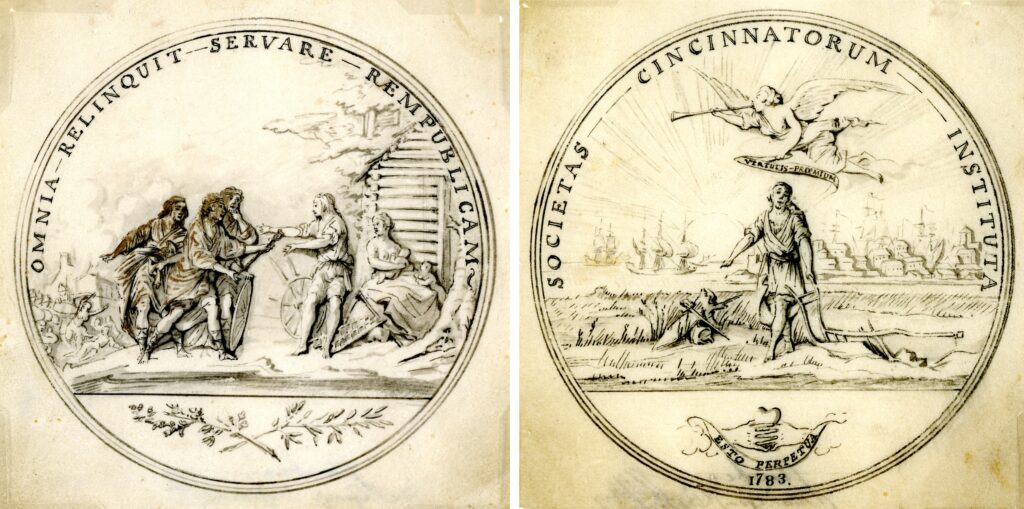
Drawing of the Society of the Cincinnati medal
Pierre-Charles L’Enfant
June 1783The Society of the Cincinnati Archives
At the request of the Society, Pierre-Charles L’Enfant, a French volunteer in the Continental Army Corps of Engineers, drew a design for a medal bearing imagery of the life of the fifth-century BC Roman hero Cincinnatus, from whom the Society takes its name. The obverse, shown here, depicts Cincinnatus receiving his sword from Roman senators as he leaves home to lead his country against its enemies. The reverse features the victorious Cincinnatus returned to his plow, with the figure of Fame flying over him holding a banner that reads “Virtutis Praemium.”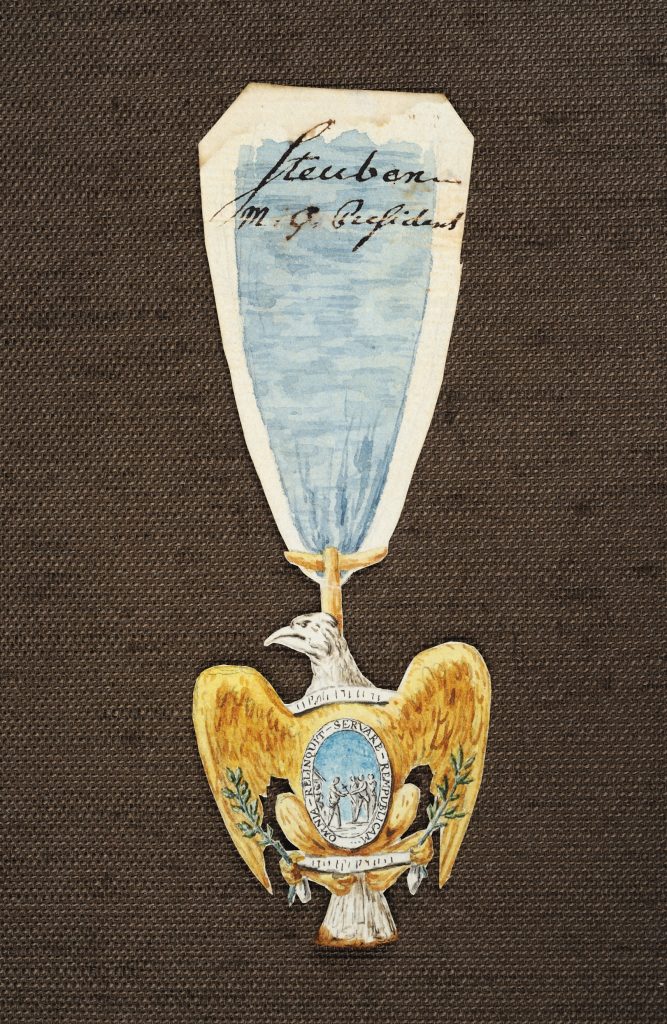
Drawing of the Eagle of the Society of the Cincinnati
Pierre-Charles L’Enfant
June 1783The Society of the Cincinnati Archives
This cutout of the design for a badge in the form of an eagle suspended by a blue-and-white ribbon was submitted by L’Enfant as an alternative to the medal described in the Institution. In June 1783, the Society adopted the Eagle as its official insignia. General Steuben, acting as president pro-tem of the Society, boldly signed his name across the top of the ribbon, consigning this original watercolor drawing to the archives. L’Enfant made additional copies of the Eagle design, which were circulated among the state branches to encourage orders.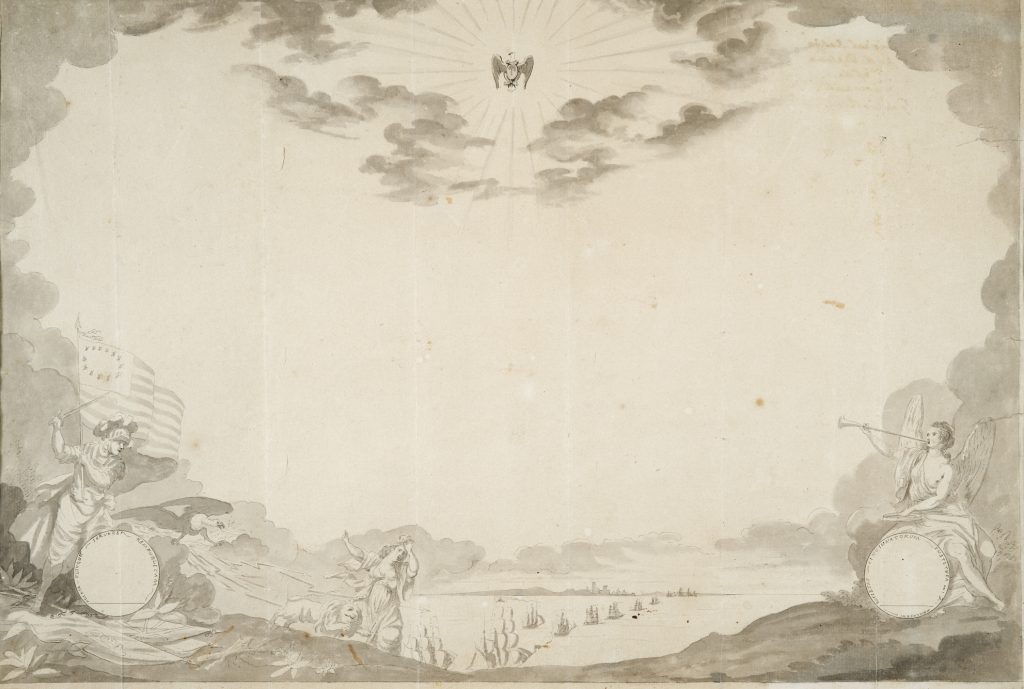
Drawing of the diploma of the Society of the Cincinnati
Pierre-Charles L’Enfant
June 1783The Society of the Cincinnati Archives
Concerned that all members of the Society might not be able to afford to purchase an Eagle, L’Enfant also submitted this design for an elegant membership certificate, to be called the diploma. The imagery depicts America forcing Britannia away from its shores, with Fame heralding the achievement of American independence. The Society adopted the diploma and the Eagle as the official emblems of membership at its June 19, 1783, meeting.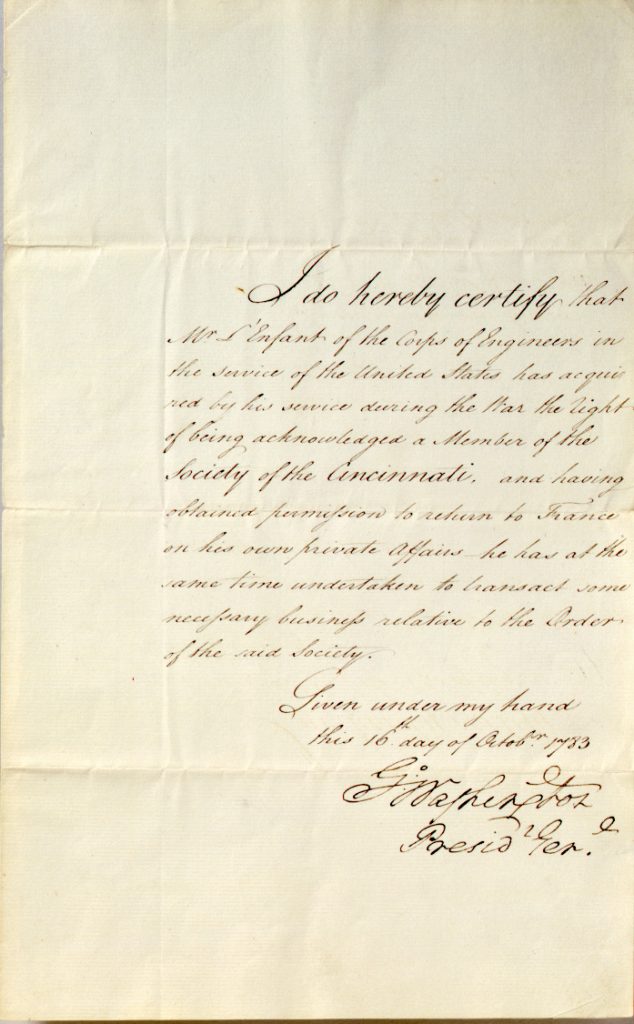
Certification of Pierre-Charles L’Enfant’s membership in the Society of the Cincinnati
George Washington
October 16, 1783The Society of the Cincinnati Archives
In the fall of 1783, L’Enfant traveled to Paris to oversee the production of the first gold Eagles and the engraving of a copperplate for the diploma. This certificate, signed by George Washington as president general, states that L’Enfant is a member of the Society and is authorized to “transact some necessary business relative to the Order” while in France.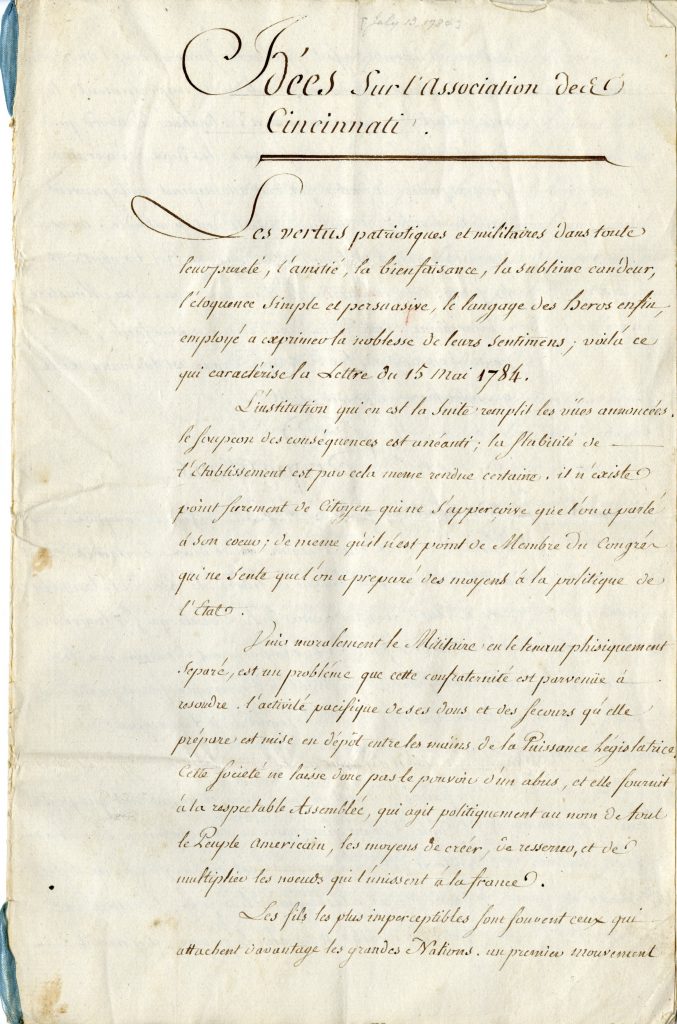
“Idees sur l’Associaton des Cincinnati”
Charles Henri, comte d’Estaing
July 13, 1784The Society of the Cincinnati Archives
Admiral d’Estaing, who served as the first president of the Société des Cincinnati de France, wrote a twelve-page essay in response to the amendments proposed to the Society’s Institution at the first general meeting held in May 1784. In addition to recommending a special structure of officers for the French branch (two vice presidents, one from the army and one from the navy), he suggested that women who have demonstrated their zeal for the American cause by supporting their husbands and fathers also be eligible to wear the Eagle of the Society.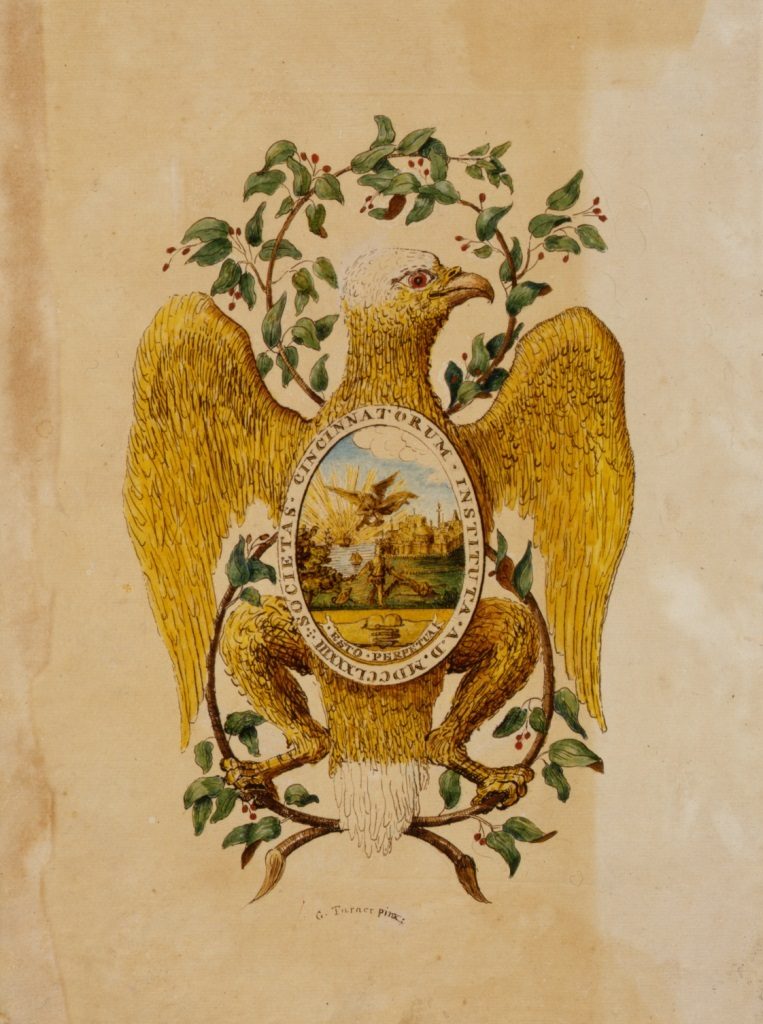
“Journals of the Society; or Order of the Cincinnati, by their Delegates in Genl. Meeting Convend May, MDCCLXXXIV”
George Turner
1784-1787The Society of the Cincinnati Archives
The minute book of proceedings of the Society’s earliest meetings was kept by Assistant Secretary General George Turner, who drew an elaborate rendering of the Society’s Eagle on its front paste-down end paper. Turner, a captain in the First South Carolina Regiment, settled in Philadelphia after the war and took an active role in gathering and organizing the Society’s papers during its first decade. He later served as a judge in the Northwest Territory.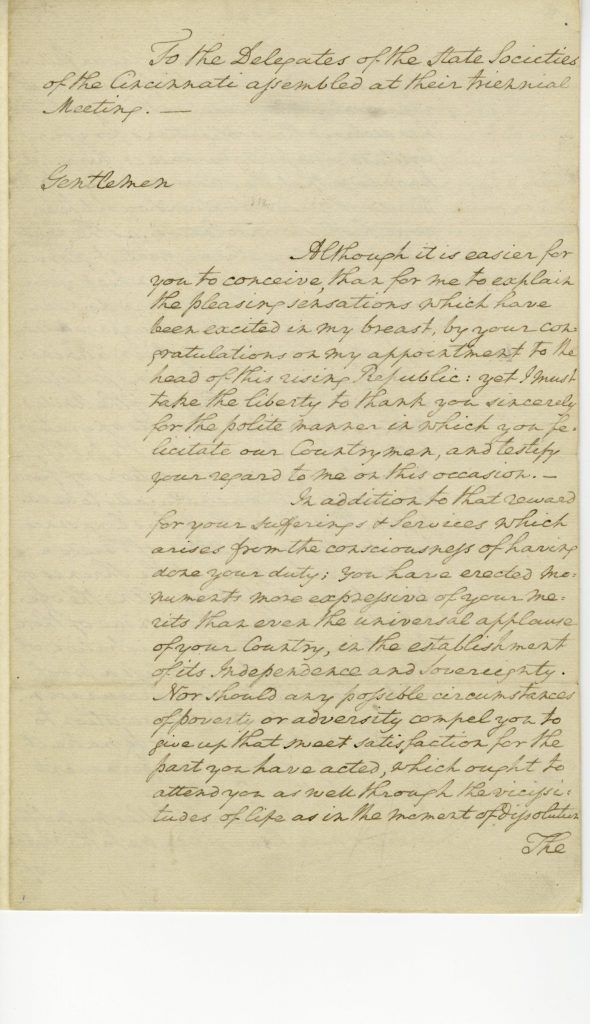
George Washington to the Delegates of the State Societies of the Cincinnati
May 1790The Society of the Cincinnati Archives
In his message to the delegates to the 1790 Triennial Meeting, Washington recognized that much of the public’s early concerns about the Society as an elitist or political force seemed to have been defused: “The candor of your fellow-citizens acknowledges the patriotism of your conduct in peace, as their gratitude has declared their obligations for your fortitude and perseverance in war. A knowledge that they now do justice to the purity of your intentions ought to be your highest consolation, as the fact is demonstrative of your greatest glory.”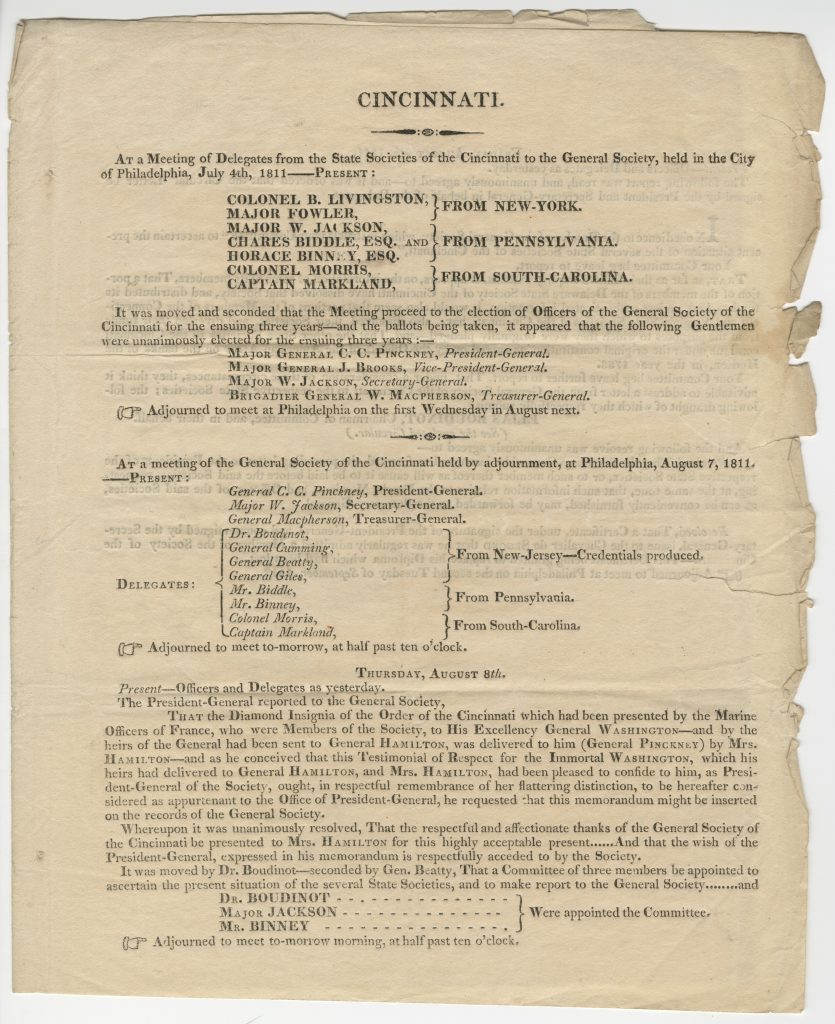
Cincinnati. At a meeting of Delegates from the State Societies to the General Society.
July 4, 1811The Society of the Cincinnati Archives
This printed broadsheet details the Society’s 1811 general meetings, the first to be called by Charles Cotesworth Pinckney since he succeeded to the office of president general following Alexander Hamilton’s death in 1804. The notable business of their August 8 meeting was Pinckney’s report that he had received from Mrs. Hamilton “the Diamond Insignia of the Order of the Cincinnati which had been presented by the Marine Officers of France…to His Excellency General Washington, and by the heirs of the General had been sent to General Hamilton.” The Society responded with a resolution thanking Mrs. Hamilton for “this highly acceptable present” and affirming General Pinckney’s recommendation that the Diamond Eagle “be hereafter considered as appurtenant to the Office of President-General.”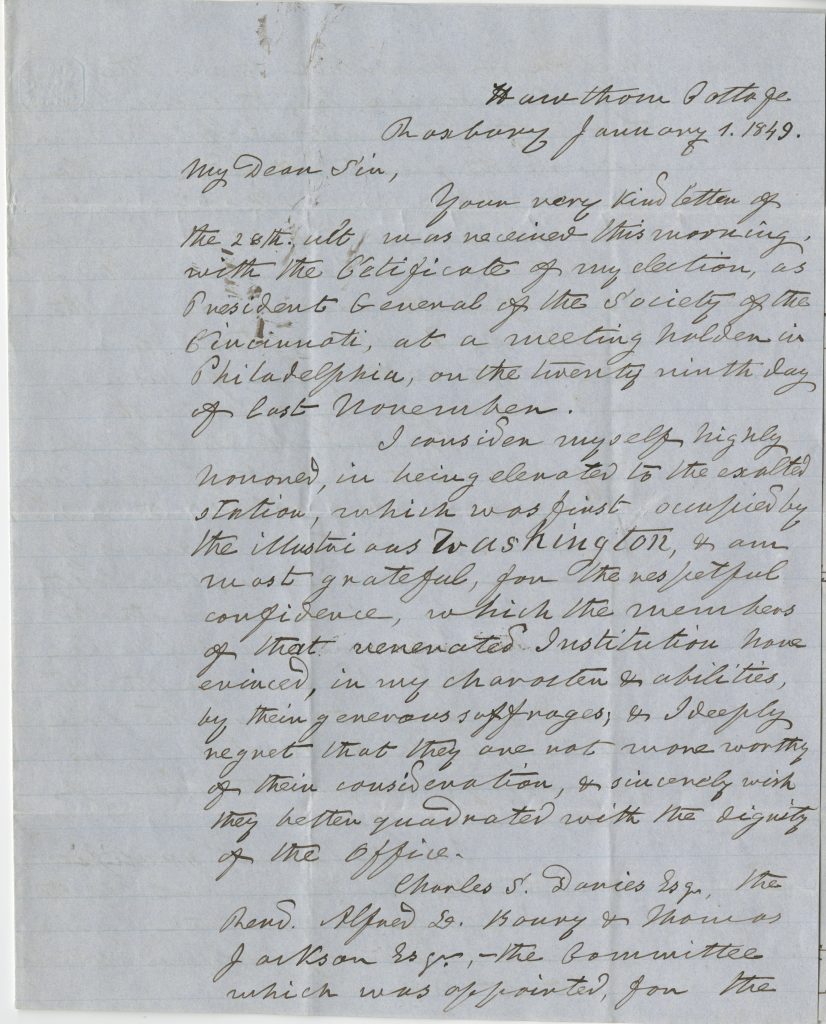
Henry Alexander Scammel Dearborn to Alexander Washington Johnston
January 1, 1849The Society of the Cincinnati Archives
When Henry Alexander Scammel Dearborn was elected the eighth president general of the Society of the Cincinnati in 1848, he became the first hereditary member to hold the office. In this letter to the Society’s secretary general, Dearborn wrote of the honor of receiving the Diamond Eagle, noting that the presentation had taken place on December 14, 1848, the forty-ninth anniversary of Washington’s death. “As a humble disciple of that Greatest and Best of Men, may I be ever emulous to imitate his preeminent virtues, & anxiously endeavor to maintain those lofty principles by which he was actuated … as one of the most decided & efficient advocates for the Rights and Liberties of his countrymen.”